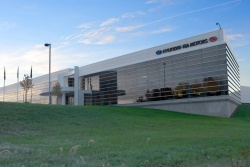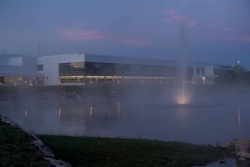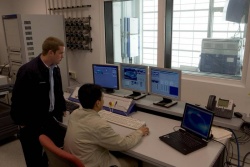 HATCI exterior. Click image to enlarge |
By Jil McIntosh; photos courtesy of the manufacturer
Photo Gallery:
HATCI
Ann Arbor, Michigan – Just a short drive out of Detroit, a visitor will discover what may be one of the prettiest areas in the state: lush fields, well-kept farms and quiet rural roads. So it’s quite a surprise to see a huge, modern building tucked up against the corn fields, and even more surprising to see what’s written on it: Hyundai Kia Motors American Technical Center. Known as HATCI, it’s the central research and development centre for the two companies in North America.
It’s also a marvel of engineering itself. It went from groundbreaking in 2004 to open-for-business in less than a year, and incorporates such facilities as engine testing, extreme climate, design engineering, product planning and system evaluation. About the only thing that can’t be done here is actual crash-testing.
 HATCI at dawn. Click image to enlarge |
It’s part of Hyundai-Kia’s overall North American strategy, and is the heart of the company’s operations. Other facilities across the continent include a proving ground in the Mohave Desert; separate Hyundai and Kia design studios in southern California; the California Chino Lab for California emissions and certification testing, as well as fuel cell evaluation; Kia Motors Manufacturing in Georgia; and Hyundai Motor Manufacturing in Alabama. Cold-weather testing is also carried out in a few other locations, including Halifax. There is no doubt that this Korean company is now truly a “landed immigrant.” About 170 people work in the Michigan facility, and overall, about 360 people work in R&D across the U.S.
It’s all part of a larger global network for the two companies. Naturally there is a corporate centre in Korea, but there are also R&D centres in Germany, Japan, India and China. One of the first things automakers learned, when moving outside of their home countries, is that a car that flies off the shelf in one market can easily flop in another, due to such factors as vehicle size, handling, design, engine size and even the fuels that are readily available. While the Michigan facility leverages knowledge from other global centres, its research is specifically for North American buyers. Here, the company currently works primarily on gasoline engines, but it’s also looking at alternative fuels and hybrids, and is working on such future projects as ten-speed transmissions and waste heat recovery.
 The powertrain laboratory. Click image to enlarge |
While Hyundai and Kia are kept at arm’s-length in design and manufacturing, the two companies share their mechanical bits and their engineering. I was visiting as a guest of Kia, and so the running joke at HATCI was that my hosts were wearing their “red hats” for the day – red being Kia’s colour, and blue being Hyundai’s. But once within the depths of the building, I saw far more than just the corporate red and blue. HATCI tears down and examines automobiles from a huge variety of manufacturers to see what works and what doesn’t. In a windshield wiper test area, for example, Honda and Toyota systems were running in a man-made shower. If they fail prematurely, the HATCI engineers find out what went wrong. If they last longer than a Hyundai-Kia system, then the engineers look to see how their systems can be improved.
Unlike some engineering facilities, HATCI gets its engineers involved at the basic levels. “We stay close to the customer,” said Dan Vivian, director of engineering design. “We think of engineering the vehicle, instead of just parts and individual systems, which is what many other engineers do. And it’s common to farm out consumer research to a consultant. Our engineers participate in customer focus groups, rather than just getting information from consultancy reports. We bring in both our own customers and those who own competitor vehicles, and if the customers prefer something on a competitor’s vehicle, we’ll focus on that.”







 Follow Autos on Twitter
Follow Autos on Twitter



